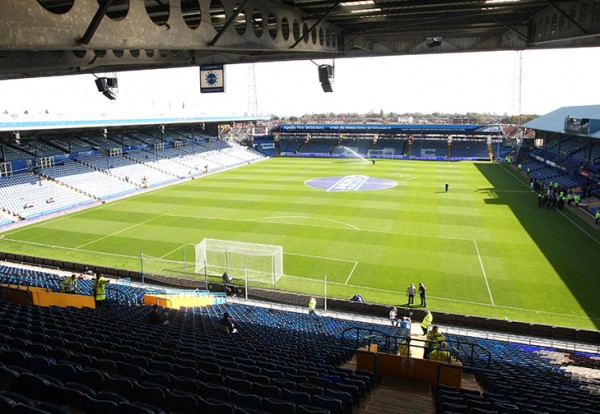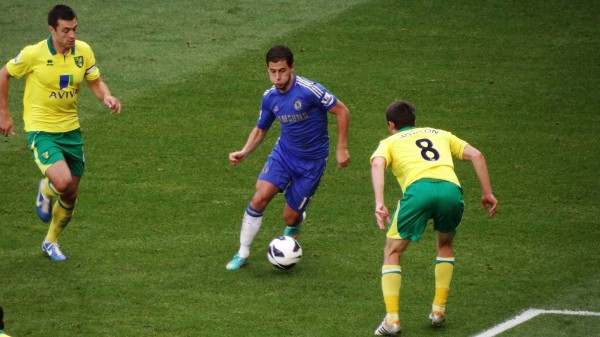 Most observers were once again left stunned by how much media companies are willing to pay to secure the rights to broadcast live games in the English Premier League (EPL). At the same time the method used to sell those rights is being investigated by Ofcom following complaints made by Virgin Media. Virgin Media actually requested that the auction was halted until the investigation was completed.
Most observers were once again left stunned by how much media companies are willing to pay to secure the rights to broadcast live games in the English Premier League (EPL). At the same time the method used to sell those rights is being investigated by Ofcom following complaints made by Virgin Media. Virgin Media actually requested that the auction was halted until the investigation was completed.
Between them, BSkyB and BT Sport have paid £5.136bn to purchase the rights to broadcast live matches in the EPL over a three-year period beginning in the 2016–17 season. This is a 71% increase in the price paid for the previous three-year deal which runs from 2013 to 2016 and cost £3.018bn. However, the headline figure hides some big differences between the amounts paid by the two companies.
How exactly are the rights sold? The broadcast rights for the 168 live matches are split up into seven different packages labelled A through to G and are placed in seven different auctions. The type of auction used by the EPL is a sealed bid auction. Interested companies are invited to make an offer for any of the packages. However, when they make a bid they do not know (a) if other firms have also made a bid and (b) the size of any other bids. Another constraint is that one firm is not allowed to win more than five of the auctions. When the auction finishes the EPL only releases information about the winning offers. It never provides information about any of the failed bids.
Some of the packages are worth more than others to the broadcasters. The first five packages (A–E) each contain the rights for 28 games per season, while the other two packages (F and G) contain the rights for 14 matches. In some of the packages all of the games kick off at the same time and on the same day. For example all 28 games in package ‘A’ kick off at 12.30pm on a Saturday. Others contain more of a mixture. Some of the games in Package E take place on a Monday evening. while others take place on a Friday evening. Given the potential advertising revenue and number of viewers, the most valuable package is D, which has 28 games that kick off at 4.00pm on a Sunday.
Another factor that influences the value of a package is the number of ‘first picks’. In any given week, more than one broadcaster might want to screen the same match. To overcome this problem, each package is allocated a number of first, second, third, fourth and fifth ‘picks’. For example, package D comes with 18 first and 10 fourth round picks. This means that whichever company wins this package will get first choice on the games they want to broadcast on 18 occasions a year. Package C contains no ‘first picks’ but offers 15 second, 4 fourth and 7 fifth round picks. There is also a maximum and a minimum limit on the number of times games including a specific team can be broadcast.

BSkyB won the auctions for packages A, C, D, E and G for a price of £4.17bn. This means that it will be paying £1.396bn to broadcast 126 live games per season. This is an average payment of £11,031,700 per game. In the previous deal it paid £760million for the rights to broadcast 116 live games per season. This is an average payment of £6,551,724 per game. The new deal represents a cost increase of 68% per game. However, the number of first picks BskyB has secured in the new deal increases from 20 to 26.
BTSport won the auctions for packages B and F for a price of £960m. This means that it will be paying £320m for the rights to broadcast 42 live games per season. This is an average payment of £7,619,048 per game. In the previous deal it paid £246 million per year for the rights to broadcast 38 live games per season. This is an average payment of £6,473,684 per game. The new deal represents an increase in costs of 17.7% per game for BT Sport – a much lower figure than for BSkyB.
BSkyB has stated that it will cover the increase in the price it has paid for the rights with efficiency savings. However, many observers believe that it will ultimately result in significant increases in the subscription rates for SkySports. The impact of the deal on BskyB’s profit may well depend on the willingness of its customers to pay higher prices. What is the price elasticity of demand for SkySports at the current subscription rates they are charging?
There is still some uncertainty about the deal following Ofcom’s decision to investigate the legitimacy of the method used by the EPL to auction the rights. Virgin Media made a formal complaint in September 2014 about the collective selling of the live broadcast rights and argued that it was in breach of competition law. The investigation by Ofcom will make a judgment about whether the joint selling of the rights by the EPL is a contravention of Chapter I of the Competition Act 1998 and/or Article 101(1) of the Treaty on the Functioning of the European Union. An initial announcement will be made in March.
Premier League set to announce record £4.4bn TV rights deal BBC Sport (10/2/15)
Premier League TV rights: What does deal mean for fans & clubs BBC Sport, Ben Smith (11/2/15)
How Sky paid £4m more per Premier League match than BT The Telegraph, Ben Rumsby (11/2/15)
Premier League TV deal: Windfall must benefit grass roots and England The Telegraph, Henry Winter (10/2/15)
Sky and BT retain Premier League TV rights for record £5.14bn The Guardian, Owen Gibson (10/2/15)
Premier League TV rights: Sky Sports and BT Sport win UK broadcasting rights as price tops £5billion Independent, Tom Peck (10/2/15)
Questions
- Draw a demand curve for package A and package D of the live broadcast rights. Which one do you think will be furthest to the right? Explain your answer.
- What are the potential benefits to the EPL of not revealing the details of any of the losing bids?
- Explain how the price elasticity of demand is a useful concept for assessing the impact of the new deal on the profits of BSkyB and BTSport.
- Given the impact of the new deal of the size of Parachute payments, what impact might it have on the level of competitive balance in the Championship?
- Find out the key provisions of Chapter I of the Competition Act 1998 and Article 101(1) of the Treaty on the Functioning of the European Union.
 Some eyebrows were raised when the English Premier League (EPL) recently published the final payments to each of the clubs from the revenue generated by the latest TV deal. The headlines were that Liverpool received the highest individual pay-out of £97,544,336! Cardiff City received the lowest pay-out of £62,082,302. What caught the eye of the headline writers was that the revenue from the lowest pay-out this season (the payment to Cardiff) was greater than the highest pay-out from the previous season (a payment of £60,813,999 to Manchester United).
Some eyebrows were raised when the English Premier League (EPL) recently published the final payments to each of the clubs from the revenue generated by the latest TV deal. The headlines were that Liverpool received the highest individual pay-out of £97,544,336! Cardiff City received the lowest pay-out of £62,082,302. What caught the eye of the headline writers was that the revenue from the lowest pay-out this season (the payment to Cardiff) was greater than the highest pay-out from the previous season (a payment of £60,813,999 to Manchester United).
The 2013-14 season was the first year of the latest 3 year deal for the rights to broadcast EPL games on the television, internet and radio. As part of this deal BSkyB are paying £760 million each year for the rights to broadcast 116 EPL games per season in the UK. BTSport are paying £246 million per year for the rights to broadcast 38 EPL games per season. In addition to selling the rights to broadcast games in the UK, the EPL also separately sells the rights to broadcast games in other countries. For example Cable Thai Holdings paid £205 million for a 3 year deal to show EPL matches in Thailand while NowTV paid £128 million for a similar deal in Hong Kong. In total the EPL earns approximately £1.8 billion per season from the sale of their domestic and international media rights.
The approach taken by the EPL to manage the sale of the broadcasting rights has raised considerable debate amongst economists and policy makers. There are two very different methods that can be used by teams in a league to sell the rights. They are the Individual Sales Model (ISM) and the Collective Sales Model (CSM). In the ISM each club is responsible for marketing and selling the rights to broadcast its home games. The ISM is currently employed by both La Liga in Spain and Primeira Liga in Portugal. In the CSM the rights are sold jointly by the league, federation or national association on behalf of the teams involved. This CSM is currently used by the majority of the football leagues in Europe. The EPL sold the rights for 2013-16 on behalf of the 20 clubs using a sealed bid auction.
 Some economists and policy makers have criticised the CSM, claiming that it is an example of a cartel that simply restricts output and leads to higher prices. Each club is considered to be the equivalent of a firm in a traditional industry. The argument is based on a number of observations about the teams. They:
Some economists and policy makers have criticised the CSM, claiming that it is an example of a cartel that simply restricts output and leads to higher prices. Each club is considered to be the equivalent of a firm in a traditional industry. The argument is based on a number of observations about the teams. They:
• are each separately owned and submit their own individual set of accounts
• compete with each other to buy inputs (i.e. the players) to produce an output (i.e. a match)
• individually market and set the price for the outputs they produce i.e. the ticket for the games and the prices of the merchandise such as football shirts
If this view of the industry is taken, the league or federation looks rather like a restrictive agreement between independent competitors that creates monopoly market power. As evidence to support this interpretation of the CSM, reference is often made to the details of the contract between the EPL and BSkyB and BTSport. As part of this agreement the number of live matches that can be broadcast is restricted to 154.This represents just over 40% of the maximum total of 380 that could be shown. Teams are effectively prohibited from individually selling the rights to matches that are not selected for broadcast in the collective deal as they must seek permission from the EPL. Over ten years ago the Director General of the Office of Fair Trading commented that:
Within the market the Premier League has a major if not unique position. By selling rights collectively…it is acting as a cartel. The net effect of cartels is to inflate costs and prices. Any other business acting in this way would be subject to competition law and I see no reason why the selling of sport should be treated differently.
The EPL has always defended it actions by claiming that any increase in the number of televised games would have a negative impact on the attendance at matches.
An alternative view focuses on the peculiar or unique characteristics of sports leagues. In particular it is argued that sport is unusual because the level of co-operation required between the teams and a league to produce matches is far greater than that required by firms in other industries to produce output. Agreements have to be made about issues such as the timing and venue of the games as well as the rules under which they will be played. However unlike a traditional cartel arrangement these agreements do not simply control and restrict output. They also improve the entertainment value of the game and hence the quality of the product. Some authors have argued that because of these unique characteristics, the league rather than the individual team should be considered as the equivalent to a firm in a more traditional industry. In this ‘single entity theory’ teams are viewed as divisions of a single organization i.e. the league. The league is treated as a natural monopoly that legally owns the broadcast rights of the clubs rather than a cartel of separate firms. Others have argued that it is more sensible to think of the league as a joint venture between the teams.
Not only are the levels of co-operation required much greater than in traditional industries but it is also argued that competitive balance is important for a successful league. If the same teams always win most of the games then there are concerns that fans will find this boring and it will reduce their willingness to pay to watch matches in either the stadium or on television. It is argued that the CSM makes it easier to distribute the TV money more equally and so helps to maintain competitive balance in a league. The White Paper on Sport published by the European Union in 2007 stated that:
Collective selling can be important for the redistribution of income and can thus be a tool for achieving greater solidarity within sports.
The debate continues about whether the CSM used by the EPL is an example of a restrictive cartel which acts against the public interest or a business practice that helps to improve the quality of the product for the customer.
Premier League clubs earn record-breaking sums thanks to TV bonanza The Telegraph (14/5/14)
Liverpool top earners over season with £99m – and bottom side Cardiff got £64m (so see what your team received in 2013-14 Mail Online (11/5/14)
Cardiff earn more TV cash than champions Man Utd did in 2013 BBC Sport (14/5/14)
Relegated Cardiff Earn More TV Revenue than Man Utd Tribal Football (14/5/14)
TV Bonanza for Premier League Clubs Pars Herald (18/5/14)
Season of woe hits home in money league Express & Star (15/5/14) .
Questions
- What is a natural monopoly? Draw a diagram to illustrate your answer.
- What is a cartel? Find three real-world examples of cartel agreements.
- It was explained in the article how the EPL sells the rights to broadcast just over 40% of the total number of matches played per season. Draw a diagram to illustrate and explain how this might be an example of a cartel agreement that restricts output and results in higher prices.
- The EPL defends its decision to restrict the number of games that can be televised in its domestic deal by claiming that any increase would have a negative impact on attendance at the matches. To what extent do you think that watching a live game on the television is a substitute for watching it in the stadium? Draw a demand and supply diagram to illustrate a situation where they are strong substitutes. Explain how the concept of cross price elasticity could be applied to this example.
- Outline how a sealed bid auction works. What are the advantages of using a sealed bid auction as opposed to other types of auction.
- Can you think of any other economics arguments that could be used to defend the use of the CSM for the sale of the broadcast rights?
The owner-occupied housing market has seen widespread coverage. With house prices falling throughout the recession and problems accessing mortgages for many people, it is this sector of housing that has received most attention. However, it is rental homes that we’ll be considering here and a new strategy being adopted by landlords. As access to mortgages dried up, people instead turned to renting. Demand for rental properties began to increase, such that competition between potential tenants increased significantly. Not only has there been a substantial increase in rents – up by some 35%, but it has also led to a new ‘sealed bid’ strategy.
A strategy that is often used for purchasing houses is where potential buyers submit sealed bids and it is this approach which is now spreading to the rental sector, as demand and competition for properties increases. Potential tenants are required to submit a sealed bid, containing the amount that they are willing to pay to rent out the property and all this must be done within a deadline. Whoever submits the highest bid ‘wins’ the property and hence tenants are encouraged to submit a bid at or close to the maximum they are willing to pay. Landlords insist that they are not trying to force tenants to pay more, but that it is simply the most effective way of letting properties that are short in supply, but face significant demand. As the BBC News article states:
‘It seems that with the current state of the housing market, sealed bids will be here to stay – as long as many would-be renters are chasing a dwindling supply of good rental homes.’
Rental ‘gazumping on the up as demand rises Metro, Tariq Tahir (8/11/10)
’Bidding war’ for homes to rent BBC News, Nigel Cassidy (20/11/10)
Rental market’s now so hot tenants are having to make sealed bids Mail Online, Sebastien O Kelly (8/11/10)
Is the buy-to-let market on its way back? Seek4Media (20/11/10)
Gazumping on the rise as London rental soars Gulf Times, London Evening Standard (8/11/10)
Questions
- Using a supply and demand diagram, explain the trend we have seen in the rental market, thinking about the impact on demand, supply and hence on price. How does this explain why sealed bids have been used to combat the increased competition?
- Which factors have affected (a) the demand for rental properties and (b) the supply of rental properties? How is the elasticity of demand and supply relevant here in terms of the impact on price?
- To what extent is a sealed bid format fair on potential tenants? Who does such a strategy favour?
- How could this sealed bid strategy be an example of price discrimination?
- What is likely to happen to your consumer surplus if you have to submit a sealed bid?
 Most observers were once again left stunned by how much media companies are willing to pay to secure the rights to broadcast live games in the English Premier League (EPL). At the same time the method used to sell those rights is being investigated by Ofcom following complaints made by Virgin Media. Virgin Media actually requested that the auction was halted until the investigation was completed.
Most observers were once again left stunned by how much media companies are willing to pay to secure the rights to broadcast live games in the English Premier League (EPL). At the same time the method used to sell those rights is being investigated by Ofcom following complaints made by Virgin Media. Virgin Media actually requested that the auction was halted until the investigation was completed.

